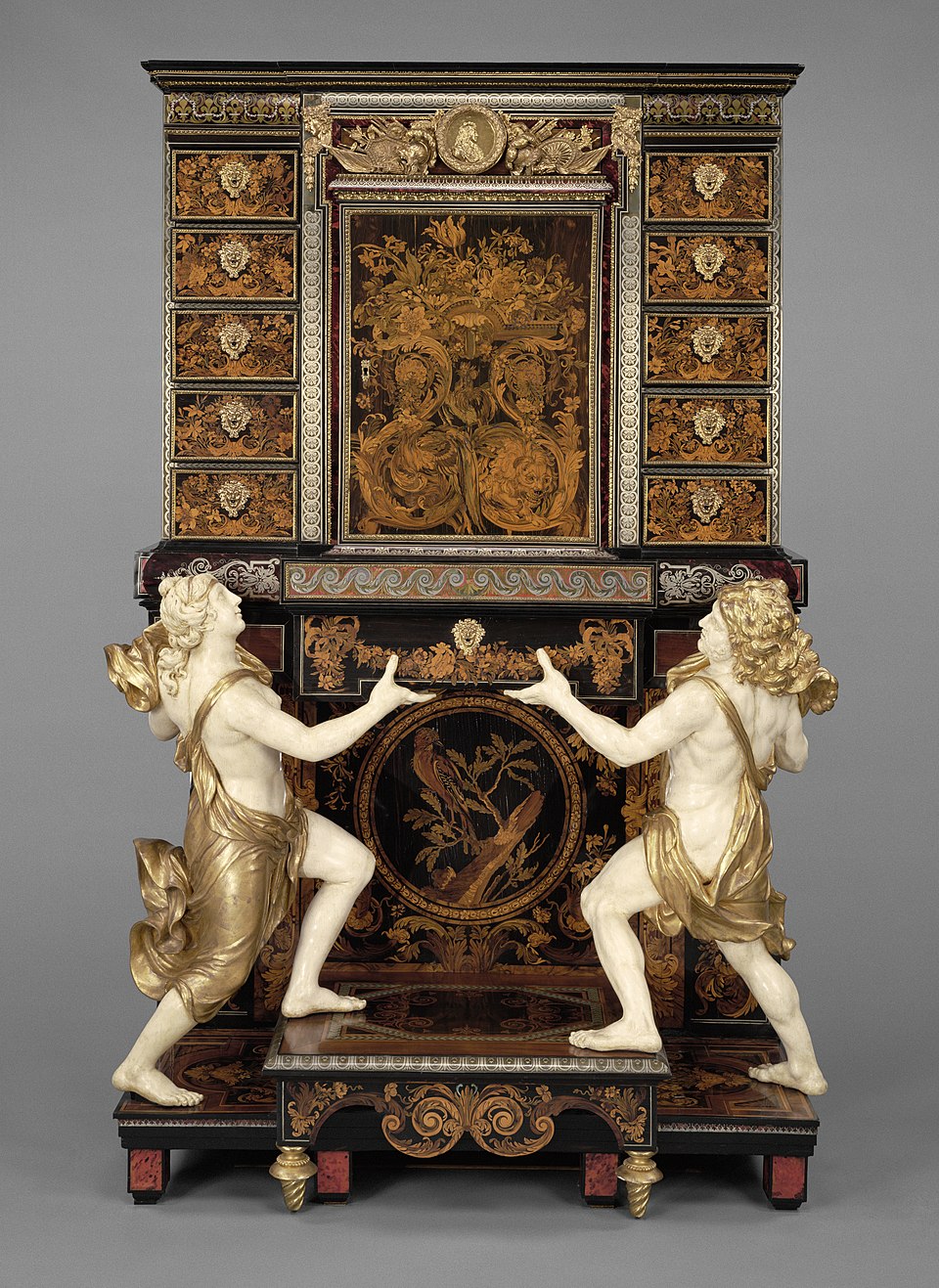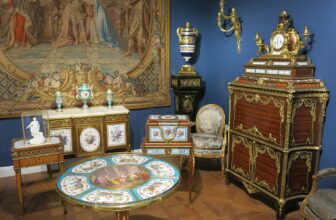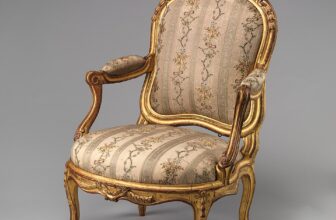
| Shopping Ads: Invest in Hidden Masterpiece: Rare Antique Oil Paintings For Sale. Limited Originals Available 💰😊 Are you looking for authentic hidden masterpiece? Explore old master antique oil paintings from the Renaissance and Baroque eras. From 16th-century portraits to 18th-century landscapes. Authenticity guaranteed, Old Master antique oil paintings for sale. Shop Now! 🎨 Renaissance And Baroque Art Landscape Antique Paintings Old Master Portrait Paintings |
A Journey into Decorative Arts, Furniture, and Ornamental Sculpture
In the resplendent corridors of Versailles, amid the golden light filtering through stained glass, the grandeur of Louis XIV-style decorative arts is eternally enshrined. Also known as the “Style Louis Quatorze”, this artistic movement emerged during the reign of King Louis XIV of France (1643–1715) and became one of the most opulent and influential aesthetic eras in European history.
More than just furniture or decoration, Louis XIV style represents an ideology, a deliberate expression of absolute power, control, and divine right. It encapsulates how art can serve a monarch, reflect a nation, and influence centuries of design to follow.
Let us journey through the majestic world of Louis XIV-style furniture, sculpture, and ornamentation, explore what made this style so unique, and discover its legacy and value today.
The Origin: Louis XIV and the Birth of a Style
Louis XIV, known as the “Sun King”, ruled France for over 72 years, the longest recorded of any monarch of a sovereign country in European history. His reign wasn’t just marked by political consolidation but also by the transformation of France into a beacon of cultural sophistication and aesthetic dominance.
From the construction of the Palace of Versailles to the centralization of French decorative arts under royal patronage, Louis XIV used art as a political tool. He understood that design could communicate power, stability, and divine favor. Under his command, craftsmanship reached new heights, and France became the center of taste and artistic innovation.
What is Louis XIV Style Furniture?
Louis XIV style furniture is a distinctive form of French Baroque art that flourished between 1660 and 1715. It was the first royal style to be officially regulated by the French monarchy through institutions like the Manufacture des Gobelins, a state-run factory for tapestries and furnishings.
This furniture was designed not only for functionality but as visual statements of power and sophistication. Each piece was carefully crafted to reflect the grandeur of the monarchy, often intended for palaces, royal courts, and aristocratic salons.
Characteristics of Louis XIV Style
1. Symmetry and Grandeur
Louis XIV furniture thrives on symmetry, balance, and geometric precision. This regularity is a core principle of Baroque architecture and design, echoing the king’s ideals of order and absolute rule.
2. Rich Materials
Materials used were among the most luxurious available: ebony, tortoiseshell, exotic woods, gold leaf, bronze, marble, and lapis lazuli. The goal was not subtle elegance but overwhelming richness.
3. Marquetry and Inlay Work
Exceptional marquetry (inlay work using pieces of wood, ivory, and metals) became a hallmark. The technique was mastered by cabinetmakers such as André-Charles Boulle, whose work remains iconic. Boulle created intricate designs featuring scrolls, foliage, and mythological scenes.
4. Gilded Bronze Ornaments (Ormolu)
Furniture was often adorned with gilded bronze mounts, known as ormolu, used to embellish legs, corners, and drawer handles. These elements were sculpted with fine detail into motifs of laurel wreaths, lion heads, cherubs, and acanthus leaves.
5. Architectural Forms
Louis XIV pieces borrowed elements from architecture. Columns, pilasters, and entablatures gave furniture a monumental presence, echoing the design language of Versailles itself.
6. Iconography and Allegory
Louis XIV style was steeped in classical and mythological references. Sunbursts (a reference to the Sun King himself), Roman gods, and classical heroes were common, suggesting divine right and the continuity of ancient empires.
7. Massiveness and Structure
Unlike the lighter, more playful furniture styles that would follow (like Rococo), Louis XIV pieces are heavy, solid, and monumental. The grandeur was in scale and mass just as much as decoration.
What Unique Things Did Louis XIV Do in Decorative Arts?
1. Established the Royal Manufactories
Louis XIV centralized production of the decorative arts by founding royal manufactories, including the Gobelin Manufactory and Sèvres Porcelain. These institutions brought together the best artists and artisans under state supervision, ensuring consistency and exceptional quality.
2. Promoted the Académie Royale
Louis XIV endorsed the Académie Royale de Peinture et de Sculpture, helping to formalize artistic training and standards. Furniture makers were required to register with the guilds and often collaborated with architects and painters.
3. Created Versailles as a Living Museum
The Palace of Versailles itself became a stage for the Louis XIV style. He transformed it from a modest hunting lodge into a symbol of his divine power, decorated with the finest examples of furniture, tapestries, sculpture, and ornamentation.
4. Commissioned Master Artisans
The king supported artists like Charles Le Brun (court painter and designer), Jean-Baptiste Colbert (chief minister and patron of the arts), and André-Charles Boulle. Their work would define the era and shape the legacy of French decorative arts.
The Role of Sculpture and Ornament
While furniture was a key element, ornamental sculpture played an equally vital role in defining the Louis XIV style.
Architectural Ornamentation
Columns, doorways, and ceilings were decorated with high-relief sculptural elements, grotesques, floral motifs, trophies, and medallions. These conveyed themes of war, victory, and divine authority.
Garden Sculpture
Versailles’ gardens featured elaborate fountains, statues of gods, allegories of the seasons, and epic battle scenes. These sculptures extended the stylistic unity from the palace into nature.
Interior Decoration
The interiors of royal residences glowed with sculptural stucco work and gilded wood paneling. Boiseries (wood paneling) became canvases for ornamental expression, rich with shells, volutes, and classical busts.
Louis XIV Furniture in the Modern Market: Value and Legacy
Today, authentic Louis XIV furniture is among the most sought-after and expensive collectibles in the world. Prices vary depending on provenance, condition, maker, and rarity.
How Much Is Louis XIV Furniture Worth?
-
Museum-quality or royal provenance pieces: Can fetch $500,000 to over $2 million at major auction houses like Sotheby’s or Christie’s.
-
Fine examples from the period: Typically range from $50,000 to $300,000.
-
19th-century reproductions (Louis XIV Revival): These can still be valuable, often priced between $5,000 to $30,000.
-
Modern interpretations or inspired styles: Vary widely from $1,000 to $10,000, depending on craftsmanship and materials.
Collectors often seek out:
-
Boulle cabinets and desks
-
Commode en arbalète (bow-fronted chests)
-
Giltwood armchairs (fauteuils)
-
Console tables with marble tops
-
Ornate mirrors and overmantels
The Legacy of Louis XIV Style
The Louis XIV style established France as the undisputed cultural leader of Europe. Its influence is visible in subsequent movements:
-
The Regency Style (1715–1730) retained many elements but softened the rigidity.
-
The Louis XV (Rococo) period reacted against the severity with curves and whimsy.
-
The Louis XVI (Neoclassical) period revived classical austerity but retained craftsmanship ideals.
-
Even Empire, Victorian, and Art Deco movements borrowed from the baroque discipline of Louis XIV’s vision.
In modern times, designers such as Christian Dior, Karl Lagerfeld, and Philippe Starck have all drawn inspiration from the Sun King’s aesthetic, blending contemporary elements with baroque opulence.
A Style Beyond Time
The Louis XIV style is not merely a relic of the past but a living monument to the power of design. Its legacy continues in the halls of museums, the salons of collectors, and the ateliers of craftsmen who still study and replicate its glorious language of form and meaning.
At its heart, the Louis XIV style speaks of a time when art was commanded by kings, when every chair and tapestry was a declaration of dynastic immortality. To own a piece of this style is to hold not just furniture, but history itself, shaped in wood, gilded in gold, and born under the sun of France’s most powerful monarch.



